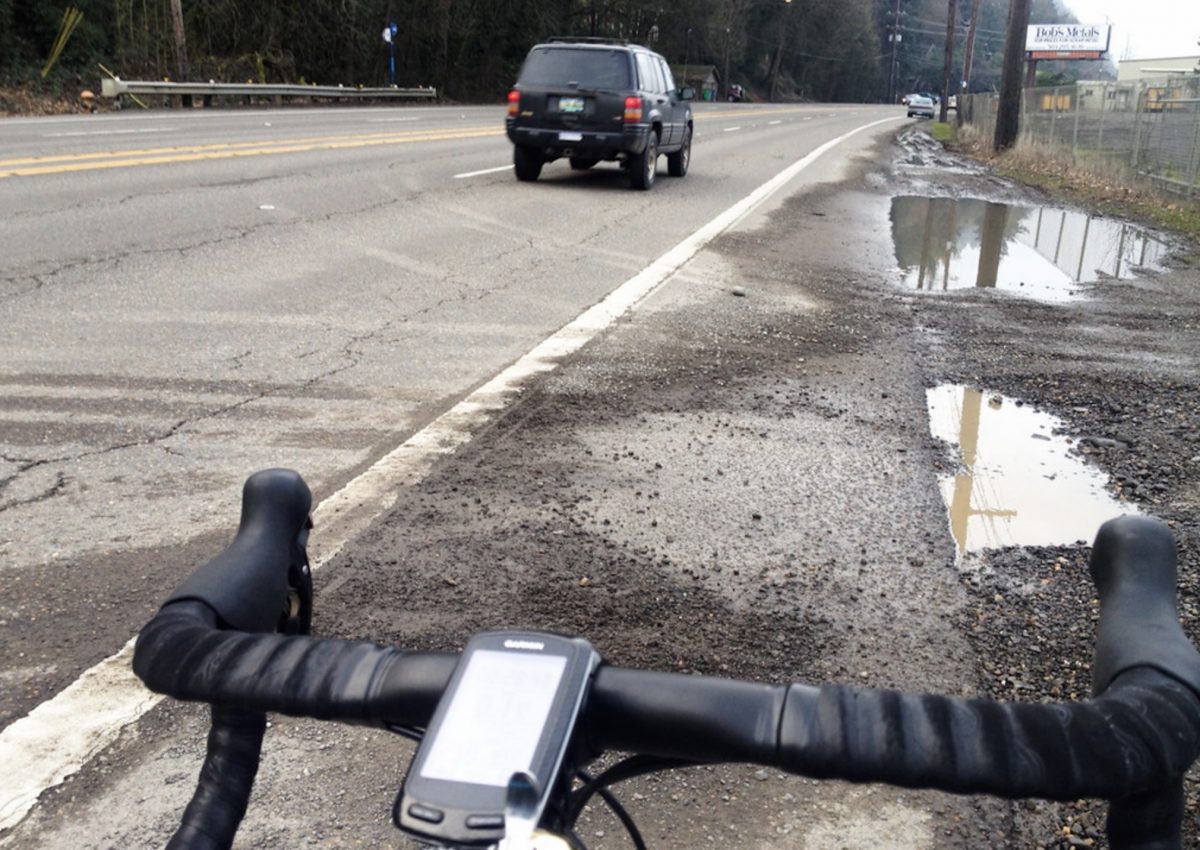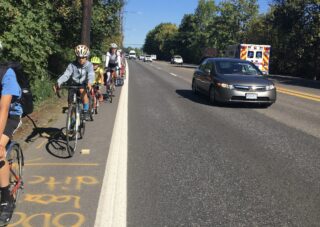
(Photos: Jonathan Maus/BikePortland)
Thanks to outside pressure, the Oregon Department of Transportation (ODOT) now says a major repaving project on U.S. Highway 30 will include several elements that should lead to better cycling conditions.
“Our design team is working now to find creative ways to improve the roadway for people using bikes.”
— Ellen Sweeney, ODOT
As we shared back in February 2019, ODOT’s $8.5 million U.S. 30 NW Industrial Area Repavement Project will impact a key, 2.5 mile section of what local riders call “Dirty 30” — from the St. Johns Bridge to NW Saltzman Road (and perhaps further south to Kittridge depending on budget).
Hwy 30 is a very popular route for cycling because it’s the only direct and flat connection from northwest Portland to St. Johns, Sauvie Island, and all the great cycling roads in the West Hills and beyond. Unfortunately it also has very fast (50+ mph) auto and truck traffic, and the bike lane conditions are usually always terrible (hence its nickname). The lane is unprotected and narrow and often strewn with gravel and other debris. Dirty 30 has probably caused more flats than any roadway in the region.
When we wrote about this project in 2019 we wondered if ODOT would do something to address the terrible cycling conditions. In 2016 ODOT did a similar project north of the St. Johns Bridge and squandered an opportunity to make significant cycling upgrades. Fortunately, since our story ran last year we’ve heard that local advocate (and BikePortland contributor/supporter) Scott Kocher and staff from The Street Trust have also been pressuring ODOT to do more for bikes in this project.
Advertisement
Asked for an update earlier this month, ODOT Region 1 Community Affairs Coordinator Ellen Sweeney said that while it was initially planned to be “a simple repavement project”, ODOT is now, “Working to find creative ways to improve the roadway for people using bikes.”

To that end, Sweeney said they have three cycling-specific project elements in mind that should improve conditions: 6-foot bike lanes with a 1-foot buffer (except for a few pinch points); improved drainage to avoid water pooling problems; and more paving on driveway approaches to decrease the amount/likelihood of gravel reaching the bike lane.
The wider and buffered bike lanes are a welcome change, although Sweeney acknowledges there will be “a few” pinch-points where they’ll narrow to just 5 feet. “But there are other areas where the bike lanes will be wider than 6 feet,” she added. “Additional space in the shoulder will be included in the bike lane.”
As for water drainage, Sweeney said,
“We’ve heard from people using bikes about their experiences with pooling water on US 30, especially near Doane Lake. While no drainage work was originally included in the scope for this project, our maintenance team and our hydraulic engineers are working together to identify opportunities for a short term improvement (to be implemented with this project) and a long term fix (with the intention of including it in a future project).”
ODOT is still finishing final design of the project and we should know more by this coming winter. Construction of the project is expected to begin in Spring 2022.
This is a very important project and we’ll be watching it closely. Stay tuned for more opportunities to share your feedback.
— Jonathan Maus: (503) 706-8804, @jonathan_maus on Twitter and jonathan@bikeportland.org
— Get our headlines delivered to your inbox.
— Support this independent community media outlet with a one-time contribution or monthly subscription.

